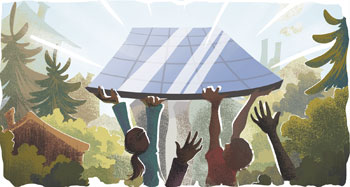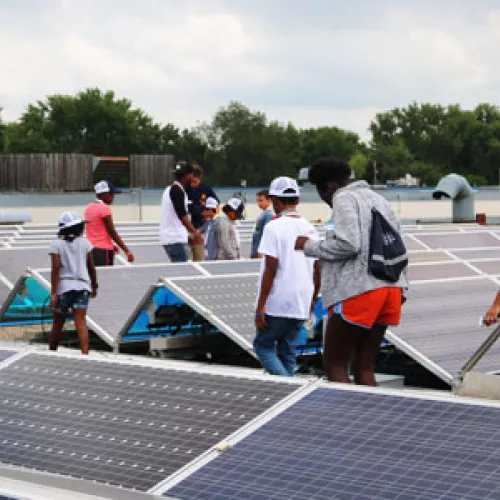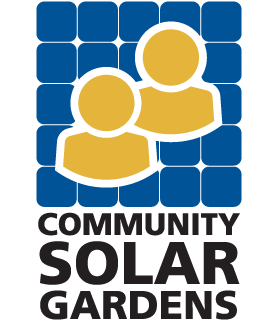While it’s true that solar energy is more affordable and prevalent than ever before in Minnesota and across the US, high up-front costs and a large share of renters still prevents many low and middle income people from benefiting from the growth in solar. To narrow this gap, a handful of groups in Minnesota have been working to increase access to solar, regardless of income.
Just Community Solar Coalition
 Just Community Solar Coalition is a project of Minnesota Interfaith Power and Light (MNIPL) and their partners: Cooperative Energy Futures, Community Power, Sierra Club, and Renewable NRG Partners. The Coalition seeks to make solar production and solar training programs accessible to all communities, and to build awareness through education. Their two model Community Solar Gardens (CSGs) projects, at Shiloh Temple International Ministries in North Minneapolis and the Edina Public Works Building, are founded on these exact values. Their belief is that CSGs can benefit low-income households in the form of stable electricity costs and utility bill credits.
Just Community Solar Coalition is a project of Minnesota Interfaith Power and Light (MNIPL) and their partners: Cooperative Energy Futures, Community Power, Sierra Club, and Renewable NRG Partners. The Coalition seeks to make solar production and solar training programs accessible to all communities, and to build awareness through education. Their two model Community Solar Gardens (CSGs) projects, at Shiloh Temple International Ministries in North Minneapolis and the Edina Public Works Building, are founded on these exact values. Their belief is that CSGs can benefit low-income households in the form of stable electricity costs and utility bill credits.
Involving Communities: Outreach to communities is of utmost importance for the Coalition to achieve their vision. The first step is their community-focused outreach model which necessitates active involvement of community stakeholders. A key feature of this model is the existence of core teams in each community that assess values, characteristics, and assets of their community to develop a marketing plan specific to that community. For example, the Edina Project is a team effort of Edina Environmental Commissions, six different congregation representatives, neighborhood organizations, and other interested individuals. Such community members are generating interest through events, dialogues, and information-sharing.
Educating Youth: As part of their outreach efforts for the Shiloh Temple project, MNIPL co-hosted its first educational camp for youth on August 8-12 in collaboration with Keith Dent, founder of Just-B-Solar Camp. “Most solar installation trainings are unreachable by public transport,” noted Dent. “For this reason, many communities of color lack access to education about solar.” The camp focused on getting youth aware and excited about solar technology and emerging career opportunities. On August 11, CERTs talked to the solar camp kids about the electricity grid and what makes for a good solar site.
Growing the Movement: Julia Nerbonne, executive director of MNIPL, shared, “This should not be a unique effort, but the beginning of a movement to make energy justice more affordable, with lots of developers and consumers joining. There should be information and assistance available for consumers choosing energy options that encourage energy access and equity.”
Rural Renewable Energy Alliance
 The Rural Renewable Energy Alliance (RREAL) has been delivering solar energy systems to low-income families since 2000 as a means of permanently addressing energy poverty. RREAL has been building the movement for expanding access to solar for the last 16 years. RREAL solves energy poverty with solar power, balancing the use of advanced technology with the interests of our environment while bringing lasting independence, economic, and social change to communities. In addition to RREAL’s flagship Solar Assistance program, RREAL provides classroom education, internship, volunteering, and hands-on training opportunities for learners of all ages through our Education and Outreach (ECO) program. RREAL provided educational opportunities to over 2,000 individuals in 2015 alone, including hands-on trainings to trade unions, tribal housing departments, workforce centers, and post-secondary educational institutions while deploying clean energy systems.
The Rural Renewable Energy Alliance (RREAL) has been delivering solar energy systems to low-income families since 2000 as a means of permanently addressing energy poverty. RREAL has been building the movement for expanding access to solar for the last 16 years. RREAL solves energy poverty with solar power, balancing the use of advanced technology with the interests of our environment while bringing lasting independence, economic, and social change to communities. In addition to RREAL’s flagship Solar Assistance program, RREAL provides classroom education, internship, volunteering, and hands-on training opportunities for learners of all ages through our Education and Outreach (ECO) program. RREAL provided educational opportunities to over 2,000 individuals in 2015 alone, including hands-on trainings to trade unions, tribal housing departments, workforce centers, and post-secondary educational institutions while deploying clean energy systems.
Addressing Energy Poverty: On an individual level, low-income households spend on average 15-20% of their income on energy-related expenses. This puts a strain on already tight budgets and makes families significantly more susceptible to rising energy costs. Helping households save money on energy directly translates into a family’s ability to cover their other basic needs, including food, housing costs, education, transportation, child care and medical expenses. On a macro level, renewable energy provides broad community benefits, including local jobs, economic growth, private investment, utilization of local renewable resources for energy production, and lower rates of pollution. In short, solar provides significant benefits to low-income people who need it most.
Piloting Community Solar Assistance: RREAL’s first pilot Community Solar Assistance project is a 200 kW community solar garden that could serve up to 100 low-income families on the Leech Lake Reservation. The project will not only supply low-income Band members with the benefits of solar energy for years to come, it will provide training and renewable employment opportunities for Band members. The program will be integrated with the Leech Lake Energy Assistance program, efficiently incorporating into an existing low-income home energy program. “It’s the first low-income, Energy Assistance-integrated community solar project in the nation,” Edens said. Learn more in a recent article from Midwest Energy News.
Placing Minnesota in a National Context
Expanding access to solar energy for low and middle income people is a growing focus of groups in Minnesota and across the country. Here are just a couple examples of recent efforts:
- Interstate Renewable Energy Council (IREC) recently released a report, Bringing Shared Renewables to Low-Moderate- Income Consumers, that offers comprehensive guidance on how shared renewable energy opportunities can meaningfully benefit low and moderate income (LMI) households.
- Fresh Energy released a report specifically focused on broadening access to community solar garden subscriptions.
- Center for Social Inclusion, GRID Alternatives, and Vote Solar recently released a national Low-Income Solar Guide that is getting a lot of attention, which you can read more about here or download here.
- The White House and DOE just came out with a new effort to expand low and middle income solar access, and you can see their press release or their blog and video announcement.
If you watched this video and said, “Wait, did they just mention residential PACE financing?” then here’s a little more detail for you: HUD and Department of Veterans Affairs (VA) are releasing new guidance to unlock residential Property-Assessed Clean Energy (PACE) financing by outlining how properties with PACE assessments can be purchased and refinanced with Federal Housing Administration (FHA) mortgage insurance and by welcoming the use of PACE financing for Veterans Affairs (VA)-insured mortgages. In addition, DOE is releasing a draft of their updated Best Practices Guidelines for Residential PACE Financing for public comment. PACE is a tool that allows American homeowners, including low- and moderate- income households and veterans, to finance solar and energy efficiency improvements at no upfront cost and to pay back the cost over time through their property tax bill. More here.



